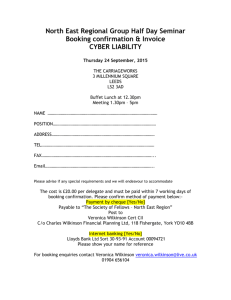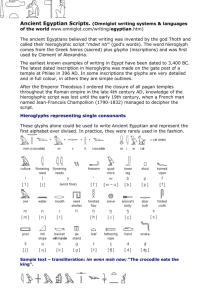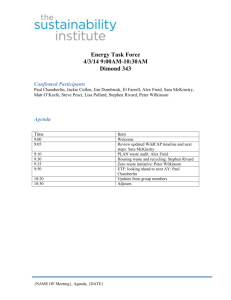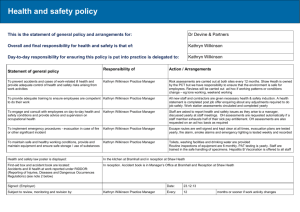HISTORY 285C/ART HISTORY 286H
advertisement
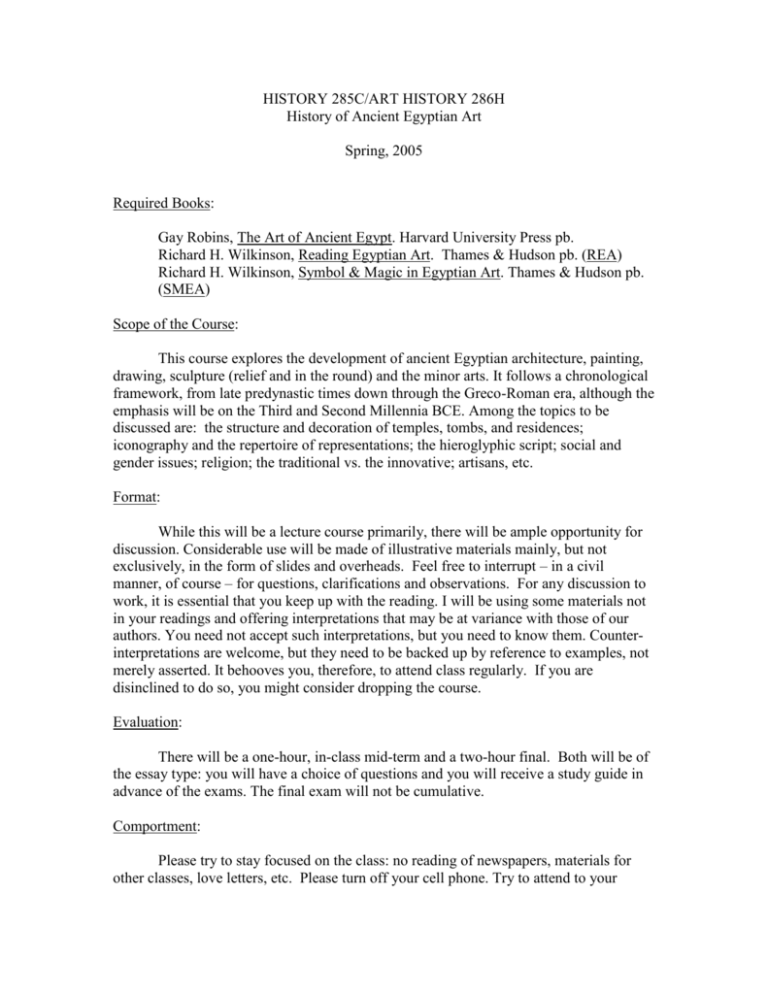
HISTORY 285C/ART HISTORY 286H History of Ancient Egyptian Art Spring, 2005 Required Books: Gay Robins, The Art of Ancient Egypt. Harvard University Press pb. Richard H. Wilkinson, Reading Egyptian Art. Thames & Hudson pb. (REA) Richard H. Wilkinson, Symbol & Magic in Egyptian Art. Thames & Hudson pb. (SMEA) Scope of the Course: This course explores the development of ancient Egyptian architecture, painting, drawing, sculpture (relief and in the round) and the minor arts. It follows a chronological framework, from late predynastic times down through the Greco-Roman era, although the emphasis will be on the Third and Second Millennia BCE. Among the topics to be discussed are: the structure and decoration of temples, tombs, and residences; iconography and the repertoire of representations; the hieroglyphic script; social and gender issues; religion; the traditional vs. the innovative; artisans, etc. Format: While this will be a lecture course primarily, there will be ample opportunity for discussion. Considerable use will be made of illustrative materials mainly, but not exclusively, in the form of slides and overheads. Feel free to interrupt – in a civil manner, of course – for questions, clarifications and observations. For any discussion to work, it is essential that you keep up with the reading. I will be using some materials not in your readings and offering interpretations that may be at variance with those of our authors. You need not accept such interpretations, but you need to know them. Counterinterpretations are welcome, but they need to be backed up by reference to examples, not merely asserted. It behooves you, therefore, to attend class regularly. If you are disinclined to do so, you might consider dropping the course. Evaluation: There will be a one-hour, in-class mid-term and a two-hour final. Both will be of the essay type: you will have a choice of questions and you will receive a study guide in advance of the exams. The final exam will not be cumulative. Comportment: Please try to stay focused on the class: no reading of newspapers, materials for other classes, love letters, etc. Please turn off your cell phone. Try to attend to your 2 bodily functions before class. Bring water if you thirst easily. If you know you have to leave early, please let me know before class begins and sit on the side you can leave with the least amount of disruption or distraction for the group or for me. Otherwise, stay put, except for emergencies or fire drills. LECTURE AND READING SCHEDULE The following is a provisional guide to the amount of time we will devote to the various periods of Egyptian art history and to the relevant readings. I say ‘provisional’ because some topics may turn out to merit fuller or more limited attention than anticipated. Fortunately, the Robins book is organized chronologically. As for the Wilkinson books: REA is intended to help you build up a repertoire of iconographic items that function both in the writing system and in representational art. SMEA is a thematic treatment of some key issues in Egyptian art. The readings are not onerous, so it should not be difficult to stay ahead. Jan. 24: Introduction to the Course Jan. 26: Studying Egyptian Art READ: Robins, 7-29; Wilkinson, SMEA, Introduction. Jan. 28: The Egyptian Language and Hieroglyphic Writing System READ: Wilkinson, REA, 8-21; SMEA, chap. 7. Jan. 31: Predynastic Art Feb. 2: The Early Dynastic Period (Dynasties 0, 1, 2) READ: Robins, 30-39. Feb. 4: Hieroglyphic Interlude I: the Body READ: Wilkinson, REA,15-55; SMEA, chap. 9. Feb. 7 – 18: The Old Kingdom (Dynasties III – VI); Form & Size. READ: Robins, 40-79; Wilkinson; SMEA, chaps. 1 & 2. Feb. 21: Hieroglyphic Interlude II: Mammals READ: Wilkinson, REA, 57-81. Feb. 23: The First Intermediate Period READ: Robins, 80-89. Feb. 25: Hieroglyphic Interlude III: Birds READ: Wilkinson, REA, 83-103. 3 Feb. 28 – Mar. 9: The Middle Kingdom and Its Aftermath (Dyns. XI-XVII); Location READ: Robins, 90-121; Wilkinson, SMEA, chap. 3. March 11: ******* Mid-term Examination ******* Mar. 14: Hieroglyphic Interlude IV: Creepy, Crawly Things READ: Wilkinson, REA, 105-115. Mar. 16 – Apr. 6: The New Kingdom, I: Dynasty XVIII; Materials READ: Robins, 122-47; Wilkinson, SMEA, chap. 4. Apr. 8 – 11: The New Kingdom, II: The Amarna Episode READ: Robins, 148-65. Apr. 13 - 18: The New Kingdom, III: The Ramesside Era; Color & Numbers READ: Robins, 166-93; Wilkinson, SMEA, chaps. 5 & 6. Apr. 20: Hieroglyphic Interlude V: Botanica, Sky, Earth and Water READ: Wilkinson, REA, 116-37. Apr. 22-27: Egypt, 1075 – 332; Actions READ: Robins, 199-255; Wilkinson, SMEA, chap. 8. May 2, 4: Hieroglyphic Interlude VI: All Sorts of Things READ: Robins, 199-255; Wilkinson, REA, 138-213.. May 6: Instructor: Gerald E. Kadish Office: LT 609 x72488 e-mail: kadishg@binghamton.edu Office hours: M 3:30-4:30; W 1:10-2:10, Th 9-10 and by appointment. HIST 285C/ART HIST 286H is a 4-credit course.
